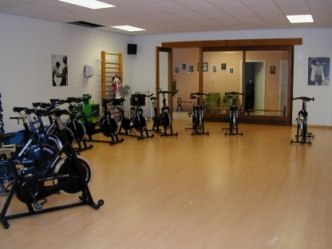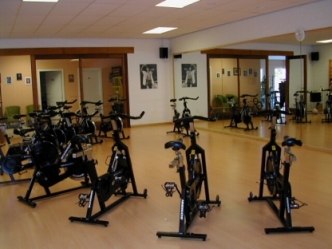

| Athletes | The Gym | History | Spinning |
 |
 |
|
monday
|
tuesday
|
wednesday
|
thursday
|
saturday
|
| 19.30 - 20.30 20.30 - 21.30 |
20.30 - 21.30 | 19.00 - 20.00 | 20.30 - 21.30 | 11.15 - 12.00 |
Spinning is one of the newest crazes in indoor fitness. Introduced in 1987, by super cyclist, Johnny Goldberg, spinning is a non-impact indoor cycling workout that can be enjoyed by participants of all ages and fitness levels. Utilizing a specially designed stationary bike, spinning classes target both the body and mind in a unique exercise program.
What is it?
Spinning is an exercise program that utilizes a specially designed stationary bicycle and a series of cycling movements that provide the participant with both a physical and mental workout. The spinning bike is designed to mimic an outdoor bicycle ride. The bike has fixed gear-racing handlebars, pedals equipped with clips or cages, and an adjustable bike seat. The intensity of your workout can be adjusted by manipulating the resistance knob, which is located on each spinning bicycle.
A typical spinning program lasts about 40 minutes and is often led by a spinning-certified instructor. During the workout, the instructor uses a variety of visual and auditory techniques to motivate the class. Participants are often led through a simulated bike ride, where they may encounter steep hills and rolling pastures. The participants are able to make adjustments on their cycles, which correspond to the difficulty of the perceived ride. Some spinning participants wear headphones that pipe in music that simulates road conditions that may be experienced in a typical outdoor bike ride.
Heart rate monitors, often worn during the workout, allow participants to gauge how hard they are working. Once the participant gets into the aerobic portion of the workout, the heart rate monitor can tell them if they are working in their target heart rate zone.
Like other well-planned aerobic workouts, spinning classes should begin with a warm-up routine and end with a cool-down segment that includes stretching exercises.
Who can participate?
People of varying ages and fitness levels can enjoy spinning. It is considered a non-impact sport, meaning it will not place undo stress on the body's joints. Spinning is non-competitive, so people of various fitness levels can enjoy this workout together.
How many calories does it burn?
Research has shown that an average 40-minute spinning workout will burn about 500 calories. The amount of calories burned by each individual will vary, depending on the intensity and duration of the workout.
Advantages
Spinning can enhance cardiovascular fitness, and improve muscle tone and exercise endurance. Spinning works various muscle groups, including the quadriceps, hamstrings, calves, hips, and abdominal muscles.
The spinning participant determines the intensity of the workout, which fosters a non-competitive class atmosphere.
For those who want to enjoy cycling year round, spinning classes are not affected by outside weather conditions. Spinning is a great way for the outdoor cycling enthusiast to stay in shape year round.
Spinning does not require that the participant learn any complicated dance steps, like some of the other aerobic workouts do. This eliminates the "intimidation factor" that is associated with certain aerobic workouts.
Guidelines for safe spinning
The spinning program is not difficult to learn. The following guidelines are recommended for all participants:
Consult with your physician before beginning any new exercise program. Pre-existing health conditions, past injuries, certain medications, and other factors can all influence your ability to safely participate in a new exercise program.
Before beginning a spinning class, become familiar with the bicycle. Learn how to stop the pedals from moving in the event of an emergency.
Be sure that the bike is properly fitted and you feel comfortable before you attempt to ride it during a class.
Seat height. Your knees should be slightly bent, when positioned at the bottom of the stroke pedal.Handlebar height. Start with the handlebars at a higher level and adjust them downward as you begin to feel more comfortable riding the bike. Your elbows should be slightly bent, with your arms in a comfortable distance from the handlebars.
Begin your ride at a comfortable pace and gradually increase it as you become more used to the bike.
If you should begin to feel dizzy or faint, slowly stop pedaling, and inform the spinning instructor immediately.
Equipment and gearCotton shirts and socks are recommended for most aerobic workouts, since this type of fiber is good at absorbing moisture. Stiffer-soled shoes are recommended for spinning.
For soreness after riding, use a padded cycling short or gel seat. Both of these items can be found in sporting goods departments and specialty stores.
A 16-ounce, sport-cap water bottle will help you to stay hydrated and can be used during the workout.
If you tend to perspire heavily during a workout, it is a good idea to bring a towel along for the ride.
Glossary of terms
Aerobics: A sustained activity that relies on oxygen for energy.
Duration: The amount of time spent at each aerobic session.
Flexibility: The ability of a bone joint or muscle to stretch.
Frequency: How often aerobic activity is performed.
Hamstring: The muscle group that is located in the back of the thigh region.
Intensity: The amount of force or energy expended during a workout.
Maximum Heart Rate (MHR): The rate at which your heart pumps blood during a very vigorous workout. Do not exceed your maximum heart rate. MHR = 220 - your age.
Quadriceps: The muscle group that is located in the front of the thigh area.
Spinning: A stationary bicycle exercise program aimed at achieving maximal energy expenditure utilizing a mind/body connection.
Stretching: Exercise which increases the ease and degree to which a muscle or joint can turn, bend, or reach.
Target Heart Rate (THR): A percentage of your maximum heart rate that should be achieved during aerobic exercise. THR can be anywhere from 60% to 90% of your MHR.
Workout: A planned series of exercises.
Sources:
American Council on Exercise (ACE)
Spinning FAQs. Mad Dog Athletics, Inc
Schwinn Cycling and Fitness, Inc, Boulder, CO, USA 1999